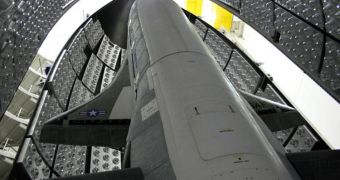For many years, analysts have been arguing for the necessity to keep weapons out of Earth's orbit. However, in more recent times, talks of a weapons race in space have been multiplying, mostly due to the tests that the United States have conducted recently. The US Air Force (USAF) launched its X-37B robotic space plane in April, while the US Defense Advanced Research Projects Agency (DARPA) conducted a failed test of its HTV-2 hypersonic glider aircraft prototype. Both machines raise serious concerns about the possibility of weapons of mass destruction making their way into space.
A factor that contributes to the controversy is the still-unclear purpose of these missions. American officials from both the Pentagon and the USAF have failed to provide transparent motivations for why they conducted the recent test flights, and so the area is opened for speculations. But the truth is that the new technologies that were demonstrated this year make taking weapons in low-Earth orbit (LEO) a very attainable goal, and one that is only a few years away. If the United States get this capability, then the Chinese and the Russian will strive to obtain it, in order to preserve the balance of global power.
Another point of concern is the fact that both China and the US have successfully tested weapons that can directly target satellites. This capability is a great asset, no doubt about it, but the tests have littered the LEO with chunks of fast-flying space debris, which now make the area a lot more insecure for future space-bound missions. At the beginning of this year, the Indian government announced that it too had begun developing similar anti-satellite systems that combine lasers with kill vehicles capable of leaving Earth's atmosphere and reaching orbit.
Experts keeping an eye on the famous “black budget” of the Pentagon say that the two new aircraft prototypes may only represent the tip of the iceberg in what could be a very complex military space program. On the other hand, they add, it could be that these moves are only performed by the military to confuse potential-enemy powers as to the country's real capabilities and intentions. As some accurately point out, even civilian-looking technologies can be used for military applications. A good example is the Global Positioning System (GPS), whose most accurate readings guide the military. Less accurate readings are sent to the general population, Space reports.

 14 DAY TRIAL //
14 DAY TRIAL //